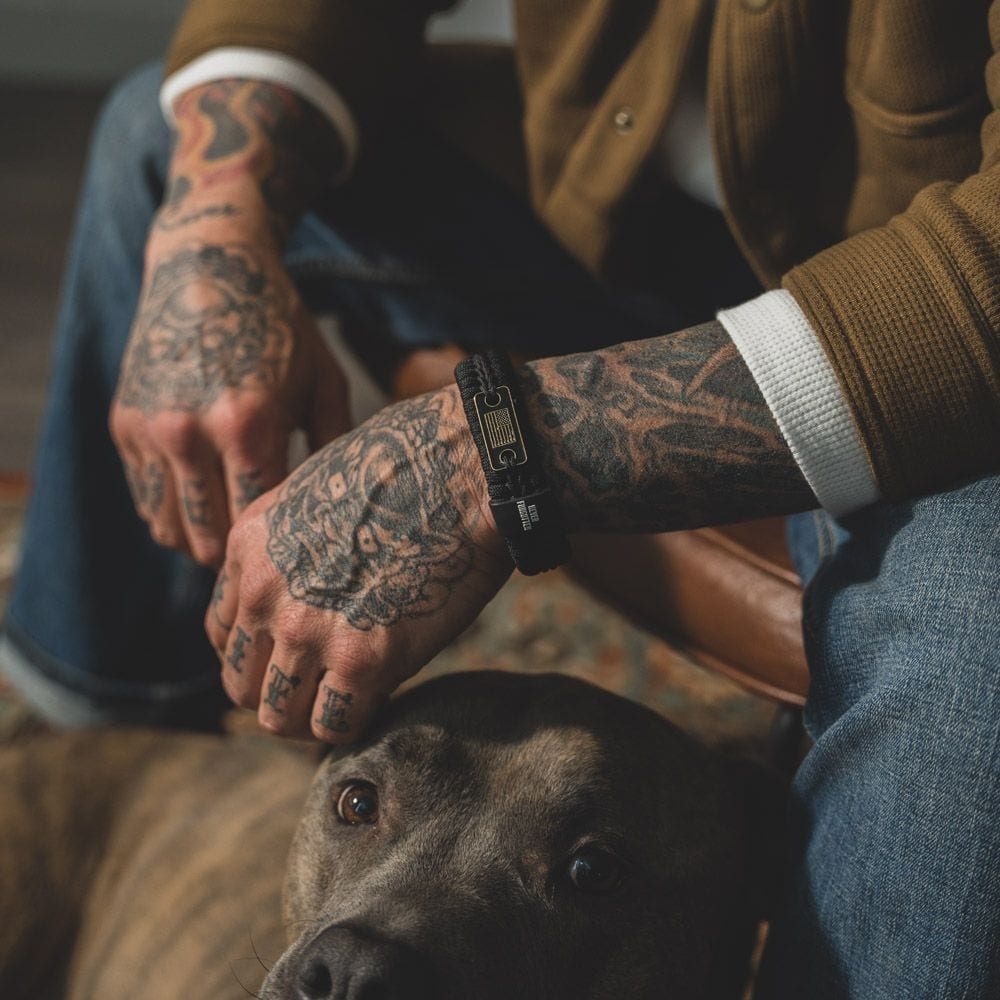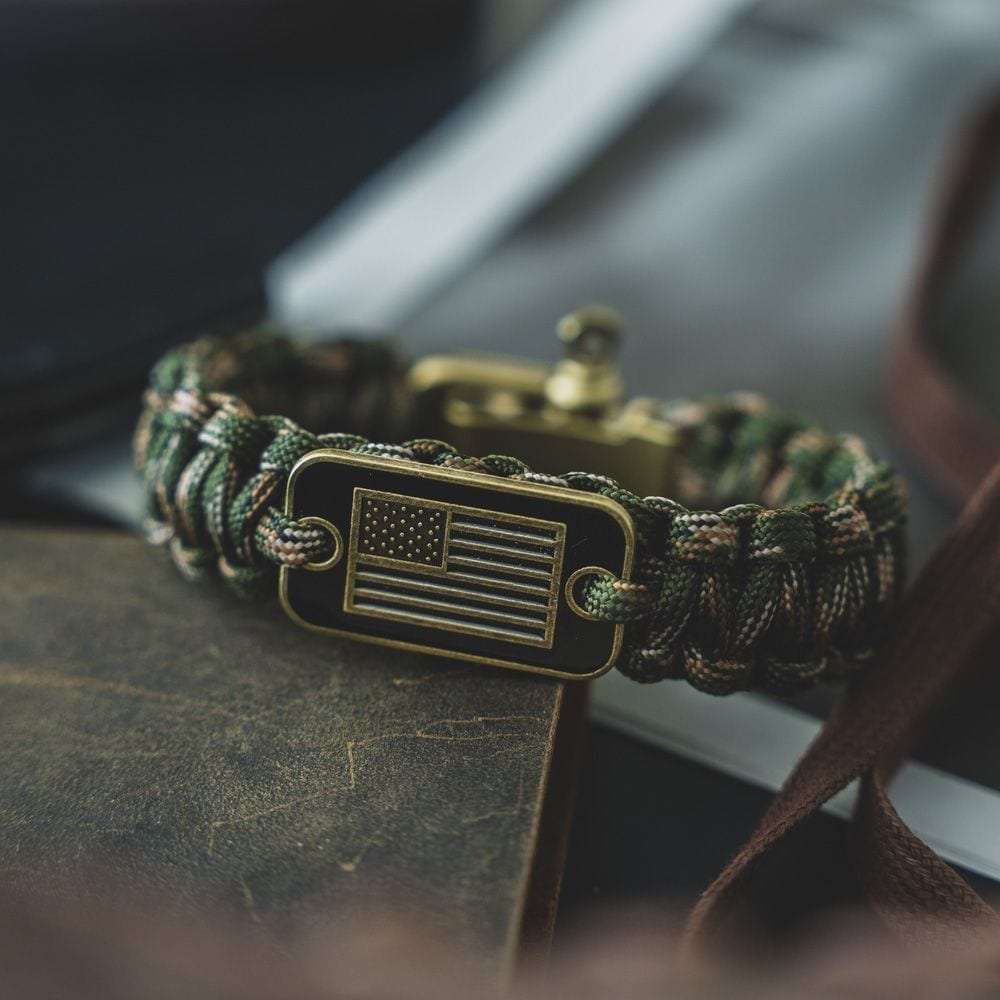Paracord Accessories & Bracelets
Showing all 8 results
American Flag Paracord Bracelets
Paracord, short for parachute cord, refers to a specific kind of rope that can be utilized for various tasks. The adaptability of paracord makes it useful to a wide range of users, including members of the armed forces, survivalists, and regular people. Continue reading to discover the ins and outs of this useful item, whether you are interested in finding out more about how to be prepared for unexpected events or would like to find out how to utilize paracord for day-to-day activities.
Why Do You Burn The Ends Of Paracord?
A lighter and a pair of scissors are essential components of any project involving paracord, regardless of its specific application. It’s made of many strands of nylon, a synthetic petroleum-based material that requires burning to finish the ends and prevent fraying. You cannot prevent fraying without burning the ends.
What Is Special About Paracord?
Paracord is unlike other ropes because of its high strength-to-weight ratio. Astronauts even used paracord to repair the Hubble Space Telescope as it’s so strong. The braided sheath’s bulk comes from its many interwoven strands, and its nylon structure makes it flexible.
Paracord was originally employed as parachutes’ suspension lines, but it is now used in almost every cordage circumstance. Survival paracord is so crucial that it’s even taught in Boy Scouts at a young age. You can find many uses for this item, including:
- Rescue Line – whether someone is caught in quicksand, drowned in water, or fallen down a ravine, paracord will keep you far enough from the danger while giving you the required leverage needed to bring a sufferer to safety.
- Shelter—In some survival scenarios, you may have to sleep outside. Paracord and tree branches can make an emergency shelter in minutes.
- Firestarter: Those who know how to perform the “bow” fire-starting method can use paracord as a bow by tying it to both ends of a bendable branch and using a stone as a socket.
- Hauling – it has the capacity to haul incredible weight for efficient transportation.
- Rope Ladder: Use two parallel cords to make a rope ladder to climb steep terrain, climb a tree, or escape a ravine.
- Fishing: If you’re lost in the woods and need to feed, there are various paracord uses that can help, such as a lure, trotline, or net.
- Bear bag: Use a bear bag to hang food to repel animals.
- Snare: With practice, you can utilize paracord as a snare trap to catch food in survival scenarios.
- Tourniquet: If you are bleeding badly and can not get to a hospital, use paracord to as a tourniquet.
- Splint: Emergency paracord splints damaged bones.
- Sling: Paracord can be used as a sling for injuries, rifles, and survival goods.
- Tripwire: Use the inner threads of your survival paracord to tie together tin cans or other noisemakers and connect it tightly between trees around your camp for security.
- Handcuffs – Paracord can be used as handcuffs for an attacker.
What Does The Army Call Paracord?
The two terms, paracord and parachute cord, are not interchangeable in any way. The 550 cord should not be confused with the 550 parachute cord, the option the military uses. The actual cord used in the construction of United States Military equipment carries the military classification MIL-C-5040 Type III and has a rated strength of 550 pounds.
Why Do People Wear Paracord?
In addition to their more common names, survival bracelets, 550 cord bracelets, and parachute cord bracelets are all names for the same item, which is a bracelet made of paracord. Anyone who spends time outside camping, hiking, or in other potentially perilous activities should have a paracord bracelet for emergency use. When it comes to surviving or getting out of dangerous situations, these wristbands come in quite handy.
Does Hot Water Tighten Paracord?
Yes, water can reduce and tighten paracord back to its original size in hot water. Putting the rope you wish to shrink into hot or boiling water and waiting about a minute, and a half should do the trick. After that, all that is left to do is wait for it to dry, and the procedure will be over.
Why Do Soldiers Wear Paracord Bracelets?
Soldiers wore paracords to assist with difficult tasks when they were in dangerous situations. Additionally, they wore paracord bracelets signifying they had each other’s backs and that they would get each other back home. It took on the role of a lucky charm for some of the service members, who reasoned that if their bracelet made all the difference in keeping them safe up to this point, they should not risk losing their lucky streak by removing the bracelet.
The soldiers rapidly discovered a wide variety of applications for this multipurpose cordage, such as tying up their boots, attaching objects to the outside of their packs, constructing emergency shelters, and fastening their loads. There is an almost unlimited number of ways that it may be used for useful and emergency purposes out in the field.
Does The Military Use Paracord?
Although it has a long and storied association with airborne troops and divisions, current parachutes do not require paracord for their cordage needs. Despite this, it is nevertheless used by a significant number of military forces in virtually all circumstances for its lightweight cordage options.
Can The Va Help Me Get A Service Dog?
Veterans who have been diagnosed with vision, hearing, or major mobility impairments can benefit from a service dog which the VA helps with as a benefit.
In order to be eligible for any form of medical service offered by the VA, veterans are required to enroll in the VA’s health care program. Once accepted into the program, the VA will conduct a comprehensive clinical evaluation to determine the most effective means of aiding the veteran. Veterans who are found eligible for guide or service dogs are then sent to reputable organizations to receive a service dog.
What Breed Makes The Best Ptsd Service Dog?
Golden retrievers are one of the most popular options for PTSD service dogs. They are good at physical and emotional assistance due to their intelligence and drive to please. Goldens form strong bonds with their owners, and despite their size, they appear calm and kind, which helps reassure dog-phobic people. They can also assist blind people or wheelchair-bound people with physical tasks.
Labrador retrievers are another exceptional option as emotional support dogs as they are smart, personable, and easy to train, with most loving the work. They also make fantastic pets as they are friendly and bond with their owners. Moreover, they love to get a job done, and because of their size can help people walk.
Third, German Shepherds are the first breed that comes to mind when you think of dogs who provide assistance as they are the standard. In almost every respect, German Shepherds are ideal candidates for the role of service dog because of their quick learning abilities, high level of intelligence, and ability to create strong emotional attachments with their owners.
They have a high sense of smell, which is necessary for monitoring their owners’ blood sugar levels, and they have shown themselves to be excellent guide dogs. Even as mental assistance dogs, they are excellent in every way. In spite of the fact that they are known for being fierce and extremely protective, they are also known for being calm and loving.
Some traits to look for in a service dog include the following:
- Friendly
- Form strong bonds and attachments with their owners
- Not overly protective or a danger to others
- Can handle noisy or crowed places calmly
- Have a strong desire to help
- Enjoy working
- Reliability
- Independent
- Calmness around other animals
- Predictable behavior
















 Toledo, United States.
Toledo, United States.